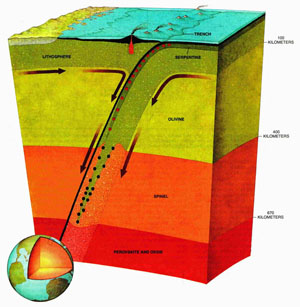| |||||||
|
|
|||||||
|
|
|||||||
| Faulting by Phase Transformation | |||||||
|
Volume reduction associated with phase transformations, such as metastable olivine to spinel, is one of the mechanisms proposed for deep earthquakes, which accounts for nearly 8% of all earthquakes. Deep earthquakes are those with epicenters below 350 kilometers, where an ordinary brittle fracturing mechanism is not favored. However, anti-cracks may be a mechanism to initiate failure there (Green, 2007). Many crystalline compounds, including some common minerals, transform to denser phases with increasing pressure. The first such transformation occurs in most parts of the mantle at a depth of about 400 kilometers (Figure 1). In the reaction, olivine, the most abundant mineral of the upper mantle, becomes unstable and changes into a phase having a spinel structure that is 6% denser than the original mineral. At 660 kilometers (Figure 1), the spinel itself becomes unstable and decomposes into two phases, magnesiowustite plus perovskite, which together are an additional 8% densification. After each transformation to a denser phase, nonhydrostatic stress build-up is likely. This model is supported by several laboratory experiments that produced transformational faulting in an Ice I - Ice II system (Kirby et al., 1991) and in polymorphic mineral systems such as the olivine - spinel system (see, Green and Burnley, 1989; Burnley and Green, 1991).
| |||||||
| Reference: |
|||||||
| Burnley, P., Green, H.W., II, 1991 Green, H.W., II, Burnley, P., 1989 Green, H.W., II, 2007 Kirby, S.H., Durham, W.B., Stern, L.A., 1991 |
|||||||
|
Readme | About Us | Acknowledgement | How to Cite | Terms of Use | Ⓒ Rock Fracture Knowledgebase |
|||||||
